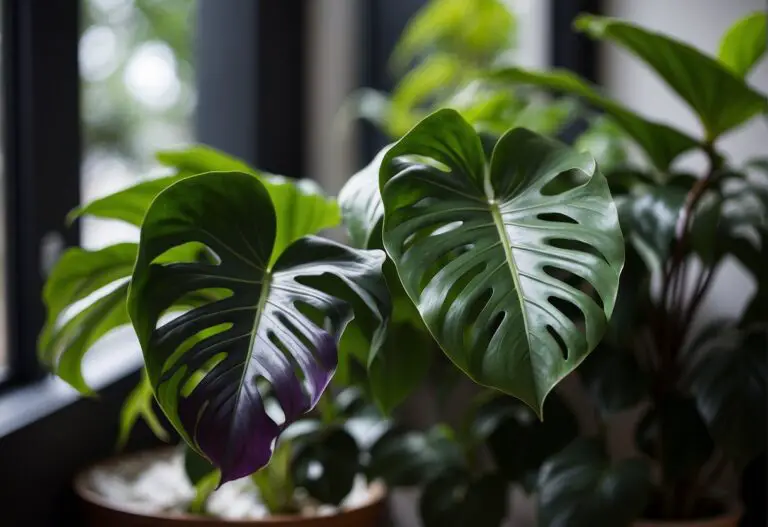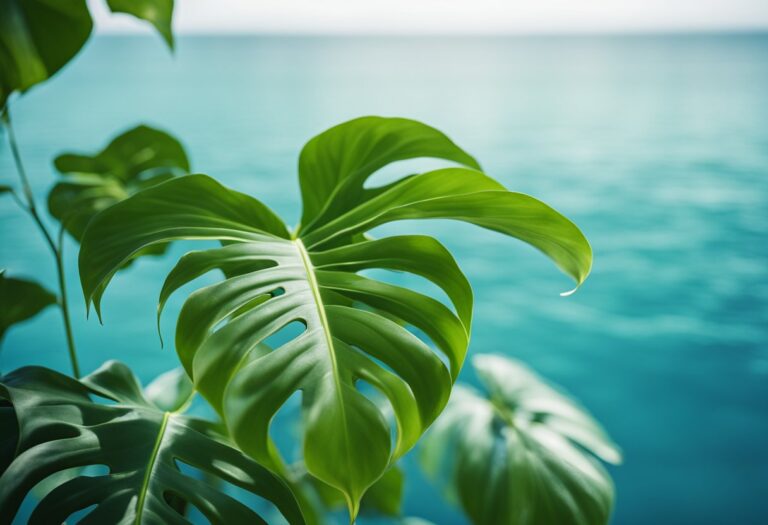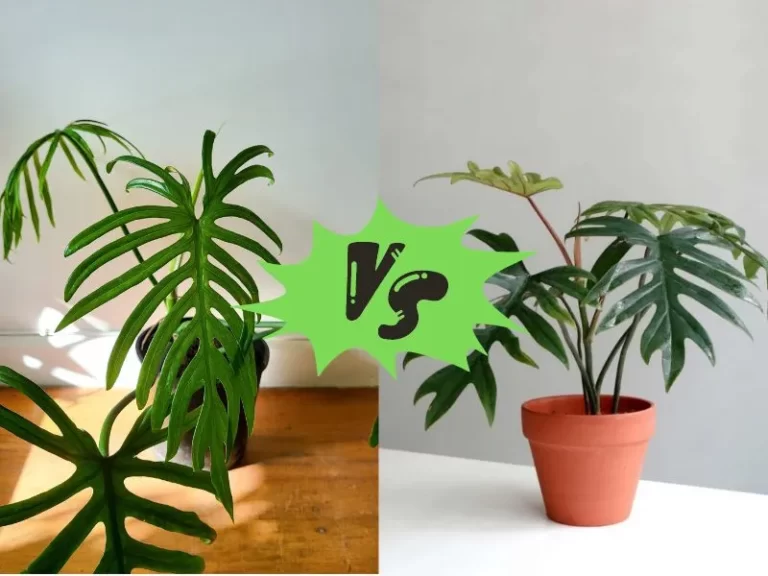Philodendron Imperial Red vs Red Emerald: Which One Should You Choose?
Philodendrons, popular houseplants known for lush foliage and ease of care, include sought-after varieties like the Philodendron Imperial Red and the Red Emerald. In this article, we’ll compare these two, helping you choose the right one for your home.
Philodendrons, native to South America and part of the Araceae family, boast large, glossy leaves in various shapes and colors. They’re favored for easy care and adaptability to different environments.

The Philodendron Imperial Red, a hybrid of the Philodendron Erubescens, stands out with its striking red foliage. Growing up to 3 feet tall and wide, it thrives in bright, indirect light and well-draining soil. Caution is advised as it’s toxic to pets and humans.
On the other hand, the climbing variety, Philodendron Red Emerald, features deep green foliage and red stems. With similar care preferences and toxicity concerns, it can reach heights of 3 feet.
Key Takeaways
- Philodendrons are tropical plants that are easy to care for and come in a variety of shapes, sizes, and colors.
- The Philodendron Imperial Red is a bushy plant known for its striking red foliage, while the Red Emerald is a climbing plant known for its deep green foliage and red stems.
- Both plants prefer bright, indirect light and well-draining soil and are toxic to pets and humans if ingested.
Philodendron Imperial Red

If you’re looking for a tropical plant that’s easy to care for and adds a pop of color to your home, the Philodendron Imperial Red is a great choice. This plant has large, glossy leaves that are a deep shade of green with red undersides. Here’s what you need to know about this popular houseplant.
Appearance
The Philodendron Imperial Red is a hybrid plant that was created by crossing two different Philodendron species. It has large, heart-shaped leaves that can grow up to 18 inches long and 12 inches wide.
The leaves are a deep green color with a glossy finish, and the undersides are a reddish-purple color. The stems are also reddish-purple in color, which adds to the plant’s overall beauty.
Growth Habits
The Philodendron Imperial Red is a relatively fast-growing plant that can reach up to 3 feet tall and 3 feet wide. It prefers bright, indirect light but can also tolerate lower light conditions.
This plant does well in a variety of temperatures, but it prefers temperatures between 60 and 75 degrees Fahrenheit. It’s also important to keep the soil moist but not waterlogged, as overwatering can lead to root rot.
Care Requirements
Taking care of a Philodendron Imperial Red is relatively easy. Here are some tips to keep your plant healthy and thriving:
- Water your plant when the top inch of soil feels dry to the touch.
- Fertilize your plant once a month during the growing season with a balanced fertilizer.
- Prune your plant to maintain its shape and remove any dead or yellowing leaves.
- Keep your plant away from drafts and cold temperatures.
- Repot your plant every 2-3 years to refresh the soil and give it more room to grow.
Overall, the Philodendron Imperial Red is a beautiful and easy-to-care-for houseplant that will add a touch of the tropics to your home. With the right care, your plant will thrive and grow for years to come.
Philodendron Red Emerald
Visual Traits
The Philodendron Red Emerald is known for its stunning visual appeal. It features vibrant, glossy, heart-shaped leaves that are a deep, rich green color.
The leaves can grow to be quite large, making it an eye-catching addition to any indoor space. The plant’s stems are sturdy and can grow to be quite lengthy, showcasing its climbing nature.
Development Patterns
When it comes to development, the Red Emerald is a climbing variety. It has a tendency to grow upwards, making it an ideal choice for those looking to add a touch of greenery to vertical spaces.
The plant’s growth can be managed through regular pruning and shaping, allowing you to control its size and appearance as it matures.
Maintenance Needs
Caring for the Philodendron Red Emerald involves providing it with the right conditions. This includes ensuring it has well-draining soil, regular watering, and indirect sunlight.
Additionally, it’s important to keep in mind that all parts of the Red Emerald are toxic to humans and pets, so it’s essential to handle it with care and keep it out of reach of children and animals.
Comparative Analysis
When it comes to choosing between Philodendron Imperial Red and Red Emerald, it can be challenging to decide which one is the best fit for your home or office.
In this section, we will compare the two plants based on their aesthetic differences, cultivation contrast, and adaptability.
Aesthetic Differences
Philodendron Imperial Red and Red Emerald have some significant aesthetic differences. Imperial Red has elongated bright green leaves that are variegated with red, while Red Emerald has heart-shaped leaves that are dark green with red veins.
Imperial Red is a smaller plant, growing up to 3 feet tall, while Red Emerald can reach up to 6 feet in height.
| Characteristic | Philodendron Imperial Red | Red Emerald |
|---|---|---|
| Leaf shape | Elongated | Heart-shaped |
| Leaf color | Bright green with red variegation | Dark green with red veins |
| Plant size | Up to 3 feet tall | Up to 6 feet tall |
Cultivation Contrast
Both plants are relatively easy to care for, but they have some differences in terms of cultivation.
Philodendron Imperial Red prefers bright, indirect light, while Red Emerald can tolerate lower light conditions. Imperial Red needs to be watered when the soil is dry to the touch, while Red Emerald prefers consistently moist soil.
| Characteristic | Philodendron Imperial Red | Red Emerald |
|---|---|---|
| Light | Bright, indirect | Tolerates lower light |
| Watering | Dry soil to the touch | Consistently moist soil |
Adaptability
Philodendron Imperial Red and Red Emerald are both adaptable plants, but they have some differences in terms of their adaptability.
Imperial Red is more tolerant of cooler temperatures, while Red Emerald prefers warmer temperatures. Imperial Red is also more resistant to pests and diseases than Red Emerald.
| Characteristic | Philodendron Imperial Red | Red Emerald |
|---|---|---|
| Temperature | Tolerates cooler temperatures | Prefers warmer temperatures |
| Pests and Diseases | More resistant | Less resistant |
Expert Tips for Cultivation and Care
If you’re considering adding a Philodendron Imperial Red or Red Emerald to your houseplant collection, it’s important to know how to properly care for them. Here are some expert tips to help you cultivate and care for these beautiful plants.
Light
Both the Imperial Red and Red Emerald prefer bright, indirect light. Direct sunlight can scorch their leaves, so it’s best to keep them a few feet away from windows that receive direct sunlight.
If you notice your plant’s leaves turning yellow or brown, it may be getting too much light.
Watering
When it comes to watering, it’s important to strike a balance. You don’t want to overwater or underwater your plant. The Imperial Red and Red Emerald both prefer their soil to be moist but not waterlogged.
A good rule of thumb is to water your plant when the top inch of soil feels dry to the touch. Be sure to use a well-draining potting mix to prevent water from sitting in the bottom of the pot.
Humidity
Philodendrons prefer high humidity, so it’s a good idea to mist your plant regularly or use a humidifier to keep the air around it moist. You can also place a tray of water near your plant to increase humidity.
Soil
Both the Imperial Red and Red Emerald prefer a well-draining potting mix. You can use a standard houseplant mix with added perlite or orchid bark for drainage.
Alternatively, you can purchase or make an aroid-specific soil blend. Whatever soil you choose, make sure it’s light and airy to allow for proper drainage.
Fertilizer
During the growing season, you can fertilize your Imperial Red or Red Emerald with a balanced, water-soluble fertilizer every two weeks. Be sure to follow the instructions on the fertilizer package, as over-fertilizing can damage your plant.
Propagation
Philodendrons are easy to propagate. You can propagate your Imperial Red or Red Emerald by taking stem cuttings and rooting them in water or soil. Be sure to choose a healthy stem with at least two leaves and a node. Change the water in your propagation vessel regularly to prevent bacteria from forming.
By following these expert tips for cultivation and care, you can help your Philodendron Imperial Red or Red Emerald thrive and add a touch of tropical beauty to your home.
Frequently Asked Questions
What are the main differences between Philodendron Imperial Red and Red Emerald?
Philodendron Imperial Red and Red Emerald are two different varieties of Philodendron plants. The main differences between the two are their growth habit and leaf color.
Imperial Red has a bushy growth habit and dark green leaves with red undersides, while Red Emerald has a climbing growth habit and bright green leaves with red stems. Additionally, all parts of the Red Emerald plant are toxic to humans and pets, while the toxicity of the Imperial Red plant is mild.
How can I propagate a Philodendron Red Emerald?
There are several ways to propagate a Philodendron Red Emerald, including stem cuttings, air layering, and division.
Stem cuttings are the most common method and involve taking a cutting from the parent plant and rooting it in water or soil. Air layering involves creating a new plant from a stem without removing it from the parent plant. Division involves separating the parent plant into two or more smaller plants.
What type of soil is best for growing a Philodendron Red Emerald?
Philodendron Red Emerald prefers well-draining soil that is rich in organic matter.
A good potting mix for this plant should contain a combination of peat moss, perlite, and vermiculite. It is also important to ensure the soil is moist but not waterlogged, as this can lead to root rot.
What are the light requirements for a Red Emerald Philodendron?
Red Emerald Philodendron prefers bright, indirect light. Direct sunlight can scorch the leaves, so it is best to place the plant near a window that receives filtered light. If the plant is not receiving enough light, the leaves may turn yellow and drop off.
Why are the leaves on my Philodendron Red Emerald turning yellow?
Yellowing leaves on a Philodendron Red Emerald can be a sign of overwatering, underwatering, or too much direct sunlight. It is important to ensure the plant is not sitting in water and that the soil is moist but not waterlogged. If the plant is receiving too much direct sunlight, it should be moved to a shadier location.
Is the Philodendron Red Emerald considered a rare variety?
The Philodendron Red Emerald is considered a popular and sought-after variety of Philodendron, but it is not considered rare. It is widely available at many nurseries and online plant retailers.






